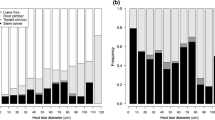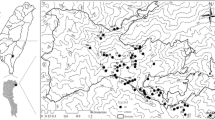Abstract
The species composition, diversity, and abundance of lianas were studied in four secondary forests (a 100-year-old forest, a middle-aged forest, and two younger secondary forests), and compared with an undisturbed primary forest in the Ailao Mountains of subtropical SW China. The results showed that the species composition of lianas differed greatly from the secondary forests to the primary forest, which exhibit early and late-successional species. The abundance of lianas was relatively higher in the two younger and middle-aged secondary forests than in the old-growth secondary and primary forests. However, liana species richness was very limited in the four secondary forests as compared to the primary forest. Root climbers mainly grew in the primary forest, whereas tendril and hook climbers predominated in the four secondary forests, while stem twiners were common in both. The majority of lianas recorded in this study reproduced by animal dispersal, and there was no variation in dispersal modes across the five forest types. A step-wise regression showed that the abundance of small lianas (dbh <4 cm) was positively correlated with the abundance of small- and medium-sized tree stems and negatively correlated with the abundance of large-sized tree stems, whereas there is a strong positive correlation between the abundance of large lianas (dbh ≥4 cm) and large tree stems. Results from the CCA indicate that canopy openness, soil moisture, and average canopy height were the most important factors that influenced the abundance and distribution of lianas.








Similar content being viewed by others
References
Appanah S, Gentry AH, Lafrankie JV (1993) Liana diversity and species richness of Malaysian rain forests. J Trop For Sci 6:116–123
Balfour D, Bond W (1993) Factors limiting climber distribution and abundance in a southern Africa forest. J Ecol 6:93–99. doi:10.2307/2261227
Brown N, Jennings S, Wheeler E, Nabe-Nielsen J (2000) An improved method for the rapid assessment of forest understorey light environments. J Appl Ecol 37:1044–1053. doi:10.1046/j.1365-2664.2000.00573.x
Chalmers AC, Turner JC (1994) Climbing plants in relation to their supports in a stand of dry rainforest in the hunter valley, New South Wales. Proc Linn Soc N S W 114:73–90
Chittibabu CV, Parthasarathy N (2001) Liana diversity and host relationships in a tropical evergreen forest in the Indian Eastern Ghats. Ecol Res 16:519–529. doi:10.1046/j.1440-1703.2001.00414.x
DeWalt SJ, Schnitzer SA, Julie S, Denslow JS (2000) Density and diversity of lianas along a chronosequence in a central Panamanian lowland forest. J Trop Ecol 16:1–19. doi:10.1017/S0266467400001231
DeWalt SJ, Ickes K, Nilus R, Harms KE, Burslem DFRP (2006) Liana habitat associations and community structure in a Bornean lowland tropical forest. Plant Ecol 186(2):203–216. doi:10.1007/s11258-006-9123-6
Gentry AH (1991a) The distribution and evolution of climbing plants. In: Putz FE, Mooney HA (eds) The biology of vines. Cambridge University Press, Cambridge, pp 3–49
Gentry AH (1991b) Breeding and dispersal systems of lianas. In: Putz FE, Mooney HA (eds) The biology of vines. Cambridge University Press, Cambridge, pp 393–426
Gerwing JJ, Schnitzer SA, Burnham RJ, Bongers F, Chave J, DeWalt S, Ewango CEN, Foster R, Kenfack D, Martinez-Ramos M, Parren M, Parthasarathy N, Perez-Salicrup D, Putz FE, Thomas DW (2006) A standard protocol for liana censuses. Biotropica 38(2):256–261. doi:10.1111/j.1744-7429.2006.00134.x
He YT, Li GC, Cao M, Tang Y (2003) Tree species diversity of a secondary broadleaved forest on Ailao Mountain in Yunnan (in Chinese with English abstract). J Trop Subtrop Bot 11(2):104–108
Hegarty EE (1991) Vine–host interactions. In: Putz FE, Mooney HA (eds) The biology of vines. Cambridge University Press, Cambridge, pp 357–375
Hegarty EE, Caballe G (1991) Distribution and abundance of vines in forest communities. In: Putz FE, Mooney HA (eds) The biology of vines. Cambridge University Press, Cambridge, pp 313–334
Ibarra-Manrıquez G, Martınez-Ramos M (2002) Landscape variation of liana communities in a Neotropical rain forest. Plant Ecol 160:91–112. doi:10.1023/A:1015839400578
Laurance WF, Perez-Salicrup DR, Delamonica P, Fearnside PM, Angelo SD, Jerozolinski A, Pohl L, Lovejoy TE (2001) Rain forest fragmentation and the structure of Amazonian liana communities. Ecology 82:105–116
Li GC, He YT, Han XG (2003) Features of gaps of middle mountain moist evergreen broad-leaved forest in Ailao Mountain (in Chinese with English abstract). Chin J Ecol 22:13–17
Magurran AE (1988) Ecological diversity and its measurement. Princeton University Press, New Jersey
Mascaro J, Schnitzer SA, Carson WP (2004) Liana diversity, abundance, and mortality in a tropical wet forest in Costa Rica. For Ecol Manage 190:3–14
Nabe-Nielsen J (2001) Diversity and distribution of liana in a Neotropical rain forest, Yasuni National Park, Ecuador. J Trop Ecol 17:1–19. doi:10.1017/S0266467401001018
Parthasarathy N, Muthuramkumar S, Reddy MS (2004) Patterns of liana diversity in tropical evergreen forests of peninsular India. For Ecol Manage 190:15–31
Phillips OL, Martinez RV, Arroyo L, Baker TR, Killeen T, Lewis SL, Malhi Y, Mendoza AM, Neill D, Vargas PN, Alexiades M, Ceron C, Di Fiore A, Erwin T, Jardim A, Palacios W, Saldias M, Vinceti B (2002) Increasing dominance of large lianas in Amazonian forests. Nature 418:770–774. doi:10.1038/nature00926
Putz FE (1984) The natural history of lianas on Barro Colorado Island, Panama. Ecology 65:1713–1724. doi:10.2307/1937767
Putz FE, Chai P (1987) Ecological studies on lianas in Lambir National Park, Sarawak, Malaysia. J Ecol 75:523–531. doi:10.2307/2260431
Putz FE, Holbrook NM (1991) Biomechanical studies of vines. In: Putz FE, Mooney HA (eds) The biology of vines. Cambridge University Press, Cambridge, pp 73–97
Qiu XZ, Xie SC (1998) Studies on the forest ecosystem in Ailao Mountains (in Chinese). Yunnan Science and Technology Press, Kunming
Reddy MS, Parthasarathy N (2003) Liana diversity and distribution in four tropical dry evergreen forests on the Coromandel coast of south India. Biodivers Conserv 12:1609–1627. doi:10.1023/A:1023620901624
Rice K, Brokaw N, Thompson J (2004) Liana abundance in a Puerto Rican forest. For Ecol Manage 190:33–41
Schnitzer SA (2005) A mechanistic explanation for global patterns of liana abundance and distribution. Am Nat 166:262–276. doi:10.1086/431250
Schnitzer SA, Bongers F (2002) The ecology of lianas and their role in forests. Trends Ecol Evol 17:223–230. doi:10.1016/S0169-5347(02)02491-6
Schnitzer SA, Dalling JW, Carson WP (2000) The impact of lianas on tree regeneration in tropical forest canopy gaps: evidence for an alternative pathway of gap-phase regeneration. J Ecol 88:655–666. doi:10.1046/j.1365-2745.2000.00489.x
Solorzano S, Ibarra-Manriquez G, Oyama K (2002) Liana diversity and reproductive attributes in two tropical forests in Mexico. Biodivers Conserv 11:197–212. doi:10.1023/A:1014568105221
Stevens GC (1987) Lianas as structural parasites: the Bursera simaruba example. Ecology 68:77–81. doi:10.2307/1938806
Tang CQ, Li TX, Zhu XH (2007) Structure and regeneration dynamics of three subtropical midmontane moist evergreen broad-leaved forests in southwestern China, with special reference to bamboo in the forest understories. Can J Res 37:2701–2714. doi:10.1139/X07-101
Uhl C, Buschbacher R, Serrão EAS (1988) Abandoned pastures in eastern Amazonia. I. Patterns of plant succession. J Ecol 76:663–681. doi:10.2307/2260566
Wang BR (1983) The dynamic analysis of evergreen broad-leaved forest in Xujiaba region of the Ailao Mountains. In: Wu CY (ed) Research on Forest Ecosystems on Ailao Mountains, Yunnan (in Chinese with English abstract). Yunnan Science and Technology Press, Kunming, pp 151–182
Young SS, Herwitz SR (1995) Floristic diversity and co-occurrences in a subtropical broad-leaved forest and two contrasting regrowth stands in central-west Yunnan Province, China. Vegetation 119:1–13
Young SS, Carpenter C, Wang ZJ (1992) A study of the structure and composition of an old growth and secondary broad-leaved forest in the Ailao Mountains of Yunnan, China. Mt Res Dev 12:269–284. doi:10.2307/3673670
Yuan CM, Liu WY, Yang GP (2008) Species composition and diversity of lianas in forest gaps of montane moist evergreen broadleaved forest in Ailao Mts., Yunnan, China (in Chinese with English abstract). J Mt Sci 26:29–35
Acknowledgments
This work was supported by the National Natural Science Foundation of China (No. 30470305), the Knowledge Innovation Program (No. KSCX2-YW-N-066-03), and the program of Hundreds of Talent Scientists of the Chinese Academy of Sciences (BRJH2002098). The Management Authority of the Ailao Mountain Nature Reserve is thanked for granting permission to undertaken the research reported. Messrs Yang Guoping, Li Dawen, and other staff members of the Ailao Mountains Forest Ecosystem Research Station are thanked for providing extensive aid in the fieldwork. Professors Lu Shugang and Liu Lunhui are thanked for their assistance in the identification of some liana specimens. We especially thank Professor Thomas Montgomery who offered great help to edit this manuscript. We also thank the editors of Ecological Research and their two anonymous reviewers for their constructive suggestions, which have considerably improved this paper.
Author information
Authors and Affiliations
Corresponding author
About this article
Cite this article
Yuan, Cm., Liu, Wy., Tang, C.Q. et al. Species composition, diversity, and abundance of lianas in different secondary and primary forests in a subtropical mountainous area, SW China. Ecol Res 24, 1361–1370 (2009). https://doi.org/10.1007/s11284-009-0620-7
Received:
Accepted:
Published:
Issue Date:
DOI: https://doi.org/10.1007/s11284-009-0620-7




